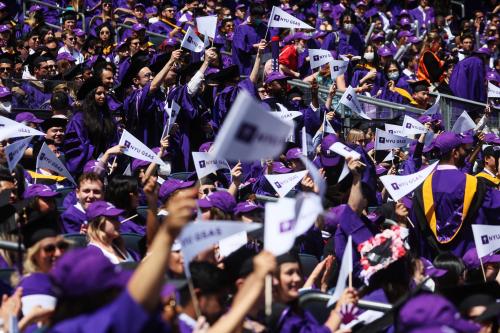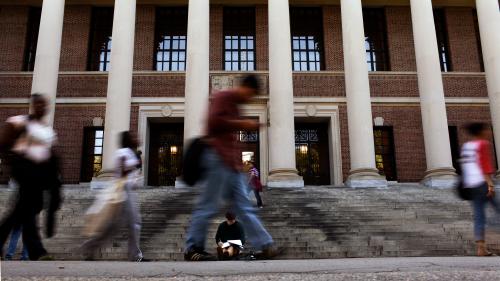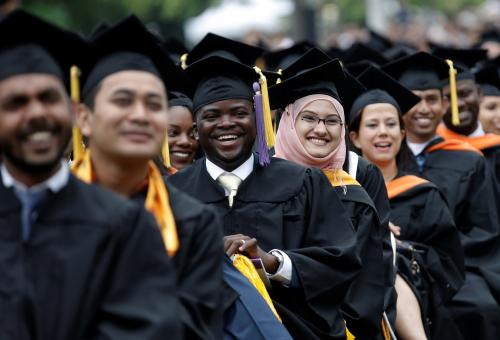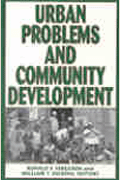The current admissions scandal is sensational and revealing. It shows the outsized power of college coaches—not just at big football and basketball powers but more or less everywhere in higher education. Even more disturbing is the spectacle of people who believe that helping their kids cheat their way into college is a form of good parenting. Still, it is helpful to put this scandal, which risks transforming perceptions of higher education at least in the short run, into context.
First, the children and parents struggling to get into these elite colleges and universities account for quite a small fraction of American students. Less than 5 percent of students enroll in institutions that accept less than 25 percent of their applicants. One-third go to colleges that accept more than 75 percent of their applicants. Perhaps the most important contribution these elite institutions can make is to educate their students to develop life goals that include reducing inequality, making the world a better place for its diverse population—and making it unthinkable for parents who want to improve their children’s lives to hold the values and take the actions those now in the limelight have chosen.
Second, most of the students at the Yales and Stanfords of the world get in through the front door: they work their butts off in secondary school, take every AP course they can find, do all manner of community service, join every club, and generally devote their lives to producing the best possible paper records for the college admissions people. This may not be the healthiest way to do high school—these are typically students who never take a course they might fail to get an A in so they don’t blow their shot at Williams—but they are serious students and hard workers. The real issue is that opportunities to prepare well for demanding colleges are so unequally shared in this country, and we should work to diminish these inequities. But the students who get in via the “back door”—as “development cases”—or the side door through straight-up bribery—are in fact rare, and we shouldn’t tar their fellows with the same brush.
Some responses to the recent revelations have suggested that these scheming parents are just extreme examples of parents who are too protective of their children—that cheating on admissions tests and fabricating athletic histories differs only in degree from spending a lot of money to provide the opportunities most likely to increase your kid’s chances of getting through the admissions game. And that students admitted through bribery are not so different from those admitted through standard practices that favor those from affluent backgrounds.
These are dangerous parallels to draw. No one thinks the income tax code is entirely fair, and most of us believe it is heavily biased in favor of the wealthy, but hiding your income and lying on your tax return crosses a bright line—it is not the same as paying a skilled accountant to help you find the loopholes. We should support improvements to the system that would make it harder for wealthy people to avoid paying taxes—and harder for wealth to determine who has access to an elite education. But hiring a tutor for your daughter or sending your son to a top-rated tennis camp in the summer differs not merely in degree but in kind from bribing a proctor to doctor their SAT scores. It will be hard for even the best college to undo the disastrous lesson parents teach their children through such cynical actions.
Finally, this scandal invites close scrutiny of the admission practices of the colleges themselves. Their most questionable practices include preferences in admission for the children of alumni and for students whose families have exceptional wealth or prestige. Colleges have their own reasons, both pragmatic and principled, for maintaining these practices, but there will never be a better time for colleges to weigh their costs and benefits.
We should not allow this scandal, exciting as it may be, to divert our attention from the most important issues in college access. The 95 percent of students who are not even thinking of enrolling in these elite places deserve more of our attention than they generally get. Almost 90 percent of the students who enroll full time at four-year colleges that accept less than 25 percent of their applicants graduate within six years; about 40 percent of those attending four-year institutions that accept at least three-quarters of their applicants earn a degree at their first institution within six years. The biggest policy problem in American higher education is not admissions cheating among the elites. It is improving educational quality and graduation rates at the institutions that most American high school graduates attend.
The Brookings Institution is committed to quality, independence, and impact.
We are supported by a diverse array of funders. In line with our values and policies, each Brookings publication represents the sole views of its author(s).











Commentary
Putting the college admissions scandal in context
March 18, 2019